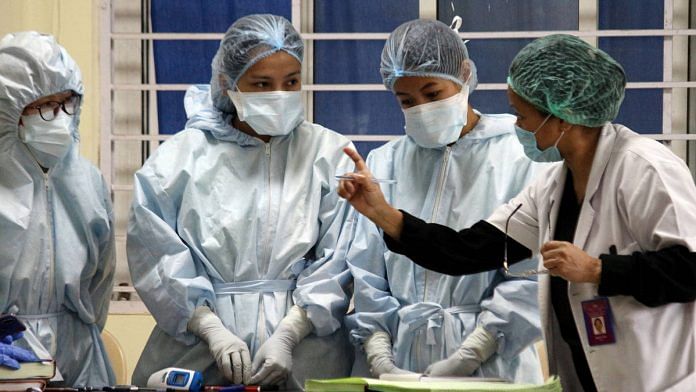New Delhi: The Government of India has so far remained tight-lipped about Covid-19 infections among healthcare workers, but now, a study published in the Indian Journal of Medical Research (IJMR) has given out what could be the first official figures — 1,073 cases had been confirmed among them until 23 May.
The study, testing the prophylactic efficacy of hydroxychloroquine, found “noteworthy” benefits of the use of the anti-malarial drug in preventing novel coronavirus (SARS-CoV-2) infections among doctors, nurses, paramedics etc.
Among the authors of the study are ICMR director general Dr Balram Bhargava, the body’s head of epidemiology and infectious diseases, Dr R.R. Gangakhedkar, and scientists from various ICMR institutes across India.
Data for the study was collected between 8 May and 23 May, and on the latter date, the total number of Covid-19 cases in the country stood at 1,30,677. This means about 0.82 per cent of the total cases in India at that point were healthcare workers, which is in line with the international experience.
A study published on 21 May in Jama Network Open, an open-access medical journal, showed that in China’s Wuhan, the initial epicentre of the coronavirus outbreak, the incidence rate among healthcare workers was 1.1 per cent.
The IJMR study said: “The ICMR data portal contained the results and contact details of 23,898 symptomatic HCWs who were tested for SARS-CoV-2 infection. After excluding non-Indian nationals and missing or wrong contact details from this database, 21,402 records were obtained, with 1,073 (5 per cent) confirmed SARS-CoV-2-infected HCWs.”
Despite repeated queries about infections among healthcare workers at its briefings, the government had not given any answers. The briefings have not been held for 11 days now.
Also read: Non-payment of salary to healthcare workers will now be an offence, Centre tells SC
Benefits of HCQ
On the effects of HCQ among healthcare workers, the study concluded that there were benefits to taking the drug as a prophylaxis or preventive measure.
“The pivotal finding of our study was the noteworthy benefits of HCQ prophylaxis. It was identified that simply initiating HCQ prophylaxis did not reduce the odds of acquiring SARS-CoV-2 infection among HCWs. However, with the intake of four or more maintenance doses of HCQ, the protective effect started emerging,” the ICMR study stated.
“A significant reduction (greater than 80 per cent) in the odds of SARS-CoV-2 infection in the HCWs was identified with the intake of six or more doses of HCQ prophylaxis,” it added.
The National Task Force for Covid-19 in India recommended once-a-week maintenance dose of HCQ for seven weeks (400 mg once weekly), following the loading dose (400 mg twice a day).
India first recommended prophylactic use of HCQ for frontline health workers on 23 March. The advisory was subsequently revised on 22 May to include all frontline health workers, even as HCQ was dropped from several international trials that were testing its efficacy as a therapeutic option.
Also read: Not sure if HCQ works but adverse effects don’t seem to be a problem, say Indian doctors
Increased risk-taking
The researchers found that there was an apparent increase in the chances of infection after the first two or three doses of the HCQ. They explained this by saying that after initially starting the drug, risk-taking behaviour — such as not using adequate PPEs or gaps in social distancing — may have increased among healthcare workers.
“While this phenomenon cannot be fully explained by the data collected through the present study, lessons from other areas of public health could be of some help. The parallels include (i) seat-belt legislations vis-à-vis speeding and road traffic casualties, and (ii) condom use promotion with unintended effects linked to greater sexual activities,” the researchers stated.
“Adams and Wilde allude to models of individual risk management which have the potential to explain such apparent paradoxes. They described that the introduction of a safety device could disrupt the balance between perceived hazards and rewards of risk-taking behaviours,” added the study.
Also read: Oxford journal turns to Gita for Covid lessons, says healthcare workers are today’s Arjunas






